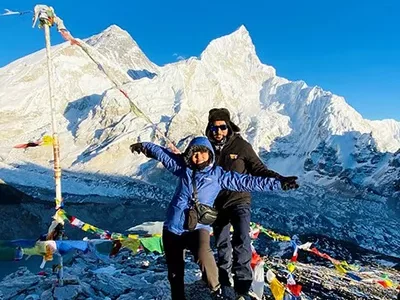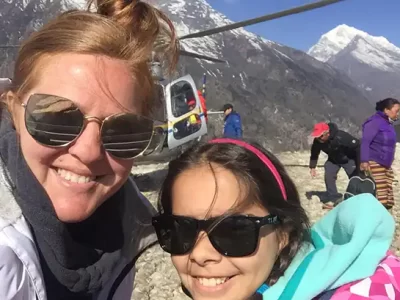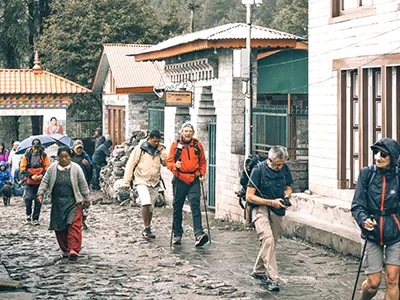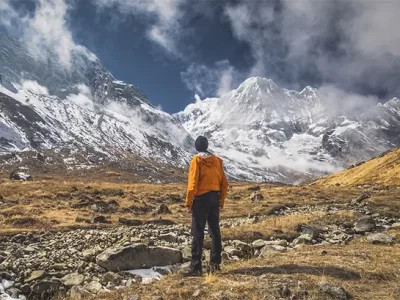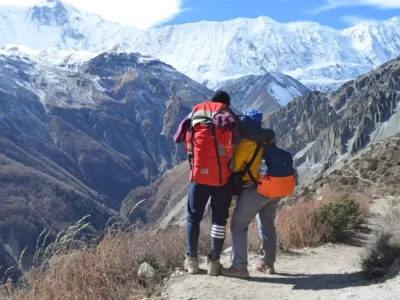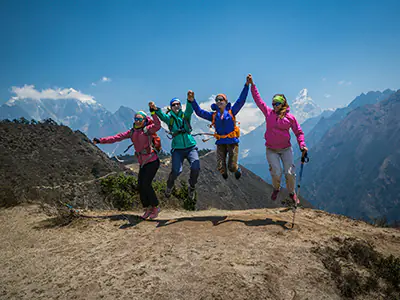Nepal, with its stunning natural beauty and rich cultural heritage, offers a climate and geography that vary significantly across regions. From the towering peaks of the Himalayas to the lush plains of the Terai, choosing the best time to visit Nepal is key to maximizing your experience.
Whether you’re planning a trekking adventure or a cultural tour, knowing the optimal time to go can greatly enhance your trip. The best month to visit Nepal depends largely on your planned activities. For trekkers, the ideal time to visit Nepal falls in the spring (March to May) and autumn (September to November).
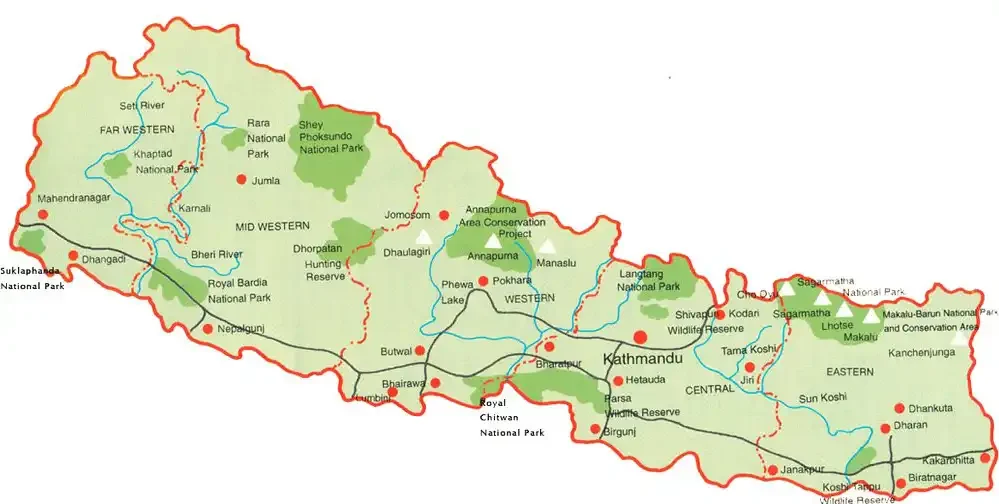
These months offer clear skies and moderate temperatures, which are ideal for trekking famous trails like Everest Base Camp and the Annapurna Circuit. If you’re more interested in cultural experiences, the best time to travel is during major festivals, which also take place in these months, adding vibrancy to your visit.
For urban and historical exploration, the best months to visit Kathmandu are the mild spring and autumn months. These periods provide comfortable weather for sightseeing without the disruptions of monsoon rains or winter chills. Similarly, the best time to trek in Nepal coincides with these seasons, providing the best conditions for outdoor activities. No matter your interests, knowing the best time for Nepal ensures you have a memorable and enjoyable trip.
Everest Base Camp Trek
Everest Base Camp Trek with Helicopter Return
Luxury Everest Base Camp Trek
Best Season to Visit Nepal
Nepal has four distinct seasons: Spring, Summer, Autumn, and Winter. Each season offers unique weather conditions and opportunities for various activities. Understanding these seasons helps you plan the perfect trip based on your interests and preferences.
1. Spring (March to May)
During spring, temperatures in Nepal range between 16°C and 23°C, creating mild and pleasant weather that makes days warm and nights cool, enabling perfect conditions for outdoor activities. There are usually clear skies, and thus, one can get breathtaking views of the Himalayan peaks.
Activities and Events
Trekking: Spring is one of the best seasons for trekking in Nepal. Moderate temperatures and clear skies make it perfect for exploring popular trails. Notable trekking routes include:
- Everest Base Camp: This iconic trek offers breathtaking views of Mount Everest and surrounding peaks. The trail passes through picturesque villages, dense forests, and high-altitude landscapes.
- Annapurna Circuit: Known for its diverse scenery, this trek takes you through lush valleys, arid deserts, and alpine forests. Crossing the Thorong La Pass at 5,416 meters is a highlight.
- Langtang Valley: This trek provides a mix of cultural and natural experiences, with opportunities to visit traditional Tamang villages and enjoy panoramic mountain views.
- Manaslu Circuit: The Manaslu Circuit is a less crowded but equally stunning trek that offers a blend of cultural heritage and natural beauty, including views of Mount Manaslu, the eighth-highest mountain in the world.
Rhododendron Blooms: One of the highlights of spring trekking is witnessing the rhododendron forests in full bloom.
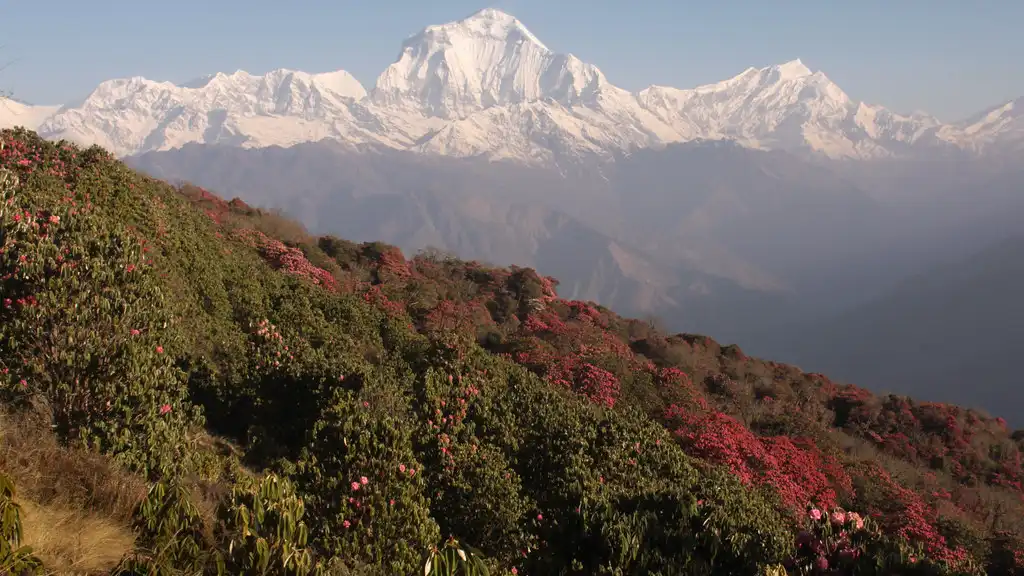
These colorful flowers blanket the hillsides, creating a breathtaking landscape. The Ghorepani Poon Hill trek is particularly famous for its rhododendron views.
Wildlife Viewing: Spring is an excellent time for wildlife enthusiasts. National parks like Chitwan and Bardia come alive with lush vegetation and active wildlife. You can spot animals such as rhinos, tigers, and various bird species during jungle safaris.
Cultural Tours: Spring offers a vibrant opportunity for cultural tours in Nepal, with many significant festivals taking place during this season. People celebrate Holi, the festival of colors, and the Nepali New Year (Bisket Jatra) with great enthusiasm, providing a unique chance to experience local culture and traditions.
Mountaineering: For those interested in high-altitude adventures, spring is the primary climbing season in Nepal. Expeditions to peaks like Everest, Lhotse, and Makalu are popular due to favorable weather conditions.
Photography: With clear skies and blooming flowers, spring provides excellent opportunities for photography. Whether capturing the majestic mountains or the vibrant cultural festivals, photographers will find plenty of inspiration.
Why Spring is Considered the Best Season to Visit Nepal
The best season to visit Nepal is spring since there are favorable weather conditions; thus, one can enjoy the beauty of the country without rain. For trekking, moderate temperates are ideal, while clear skies can ensure panoramic views of high mountains without any complication, as they are free from fog. Trails are more appealing with blooming rhododendrons, which are pink in color, making it all the more interesting even when covering long distances.
The cultural celebrations of this season go deep into the traditions and celebrations of Nepal. The wildlife watching and climbing is top-notch, offering a variety of adventures for all types of travelers. For these reasons, summer is an ideal time to explore the natural and cultural wonders of Nepal.
2. Summer/Monsoon (June to August)
In the Terai region, temperatures often soar above 37°C and reach an average temperature of 23°C to 29°C during summer months. While it gets humid during early summer with sudden thundershowers, mid-summer has continuous monsoon rains that last up to the end of August. June, July, and August are among the hottest months, and they transform the landscape through frequent rain showers.
Monsoon rains turn Nepal into a lush, green paradise. Valleys and hillsides become covered in vibrant vegetation, creating beautiful and picturesque views. However, heavy rainfall can disrupt travel plans, making roads and trekking trails muddy and slippery and increasing the risk of landslides. Persistent cloud cover often obscures views of the Himalayas, disappointing those hoping to see the peaks.
High humidity and an increase in insects and mosquitoes can make outdoor activities uncomfortable. The monsoon season may also limit tourist services. Despite these challenges, summer in Nepal offers unique experiences.
As the off-season for tourism, attractions and trails are less crowded. Many service providers offer off-season deals and discounts, making travel more affordable. The lush landscapes, green paddy fields, mist-covered hills, and vibrant rivers provide stunning views worth exploring.
Summer is also a vibrant time for cultural activities. People celebrate festivals like the Rato Machindranath Jatra, the birth anniversary of Lord Buddha, Ubhauli, Teej, and Janai Purnima with great enthusiasm.
These festivals offer a unique opportunity to experience Nepal’s rich cultural heritage and traditions. Exploring medieval villages like Khokana and Bungamati in the Kathmandu Valley gives a glimpse into traditional Nepali life, which is especially picturesque during the monsoon season.
For trekking, regions like Mustang, Dolpo, and the Tsum Valley are ideal destinations during the summer. These areas lie in the rain-shadow of the Himalayas and receive little to no rainfall, making them perfect for trekking when most other trails are wet and muddy. Adventure enthusiasts can enjoy kayaking and rafting on the swollen rivers of the Himalayas, where the rapids offer thrilling experiences during the monsoon.
Annapurna Base Camp Trek
Annapurna Circuit Trek
Everest Base Camp Trek for Beginners
3. Autumn (September to November)
Autumn in Nepal, from September to November, brings mild and pleasant weather. Average temperatures range from 15°C to 25°C, creating ideal conditions for outdoor activities. The monsoon rains recede by early September, leaving clear skies and fresh, lush landscapes. The stable weather, low humidity, and minimal rainfall provide perfect trekking conditions and enjoyable sightseeing opportunities.
Activities and Events
Trekking: Autumn is the prime season for trekking in Nepal. The clear skies and moderate temperatures are ideal for exploring the trails. Some popular trekking routes include:
- Everest Base Camp: This trek offers spectacular views of Mount Everest and the surrounding peaks. The trail combines challenging climbs with cultural experiences in Sherpa villages.
- Annapurna Circuit: This route provides diverse scenery, from lush green valleys to arid high-altitude deserts. Crossing the Thorong La Pass at 5,416 meters is a highlight.
- Langtang Valley: This trek offers a blend of cultural and natural beauty, with visits to traditional Tamang villages and panoramic views of the Langtang range.
- Manaslu Circuit: A less crowded trek, it offers stunning views of Mount Manaslu and a rich cultural experience in remote villages.
- Nar Phu Valley: This trek takes you through the hidden valley of Nar and Phu, featuring high passes, glaciers, and ancient Tibetan culture.
- Tsum Valley: Known as the “hidden valley,” it provides a unique cultural experience with ancient Buddhist monasteries and remote villages.
- Tilicho Lake Trek: Visit the highest lake in the world, Tilicho Lake, located at 4,949 meters, and enjoy breathtaking views of the surrounding mountains.
Festivals
Autumn in Nepal features major celebrations like Dashain and Tihar. Dashain, the most significant festival, spans 15 days and brings families together for gatherings, animal sacrifices, and the worship of the goddess Durga. This time-honored festival is a period for families to unite, celebrate, and perform cultural and religious rituals.
Tihar, known as the festival of lights, lasts five days and honors various animals, such as crows, dogs, cows, and oxen. The festival culminates with Bhai Tika, where sisters pray for their brother’s long life and prosperity. Homes are adorned with oil lamps and colorful rangolis, creating a vibrant and festive atmosphere throughout Nepal.
Why Autumn is the Best Time to Visit Nepal for Trekking
People prefer the Autumn season in Nepal for trekking for varied reasons, including its predictable weather patterns. The clear blue sky provides a chance for unobstructed views of the great Himalayas, which makes it a photographer’s paradise as one enjoys the beauty of nature. It is neither too hot nor too cold; thus, the moderate heat levels allow one to walk comfortably.
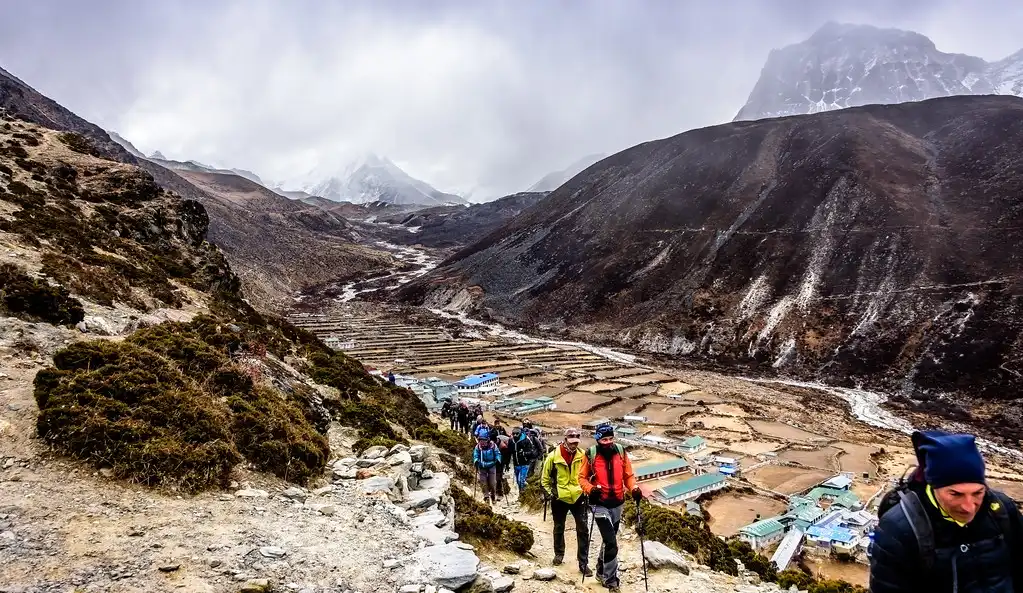
Because there is no mud along these hikes, slips are uncommon, unlike during monsoon, when landslides are the order of the day. The festive atmosphere during Dashain and Tihar adds a cultural richness to the trekking experience. Trekkers can witness and participate in local celebrations, gaining a deeper understanding of Nepali culture and traditions.
The combination of perfect trekking conditions, stunning natural beauty, and vibrant cultural festivals makes autumn the ideal season for visiting Nepal. Whether you are an avid trekker or a cultural enthusiast, this season offers a well-rounded and enriching experience, ensuring that your visit to Nepal is memorable and enjoyable.
4. Winter (December to February)
Winter in Nepal, from December to February, brings cold and dry weather. Daytime temperatures in lower regions range from 10°C to 15°C, while nighttime temperatures can drop to around 0°C. In higher altitudes, temperatures often fall well below freezing, especially at night. Despite the cold, the skies remain generally clear, offering excellent visibility of the mountains.
Activities
Lower-Altitude Trekking:
- Ghorepani Poon Hill Trek: Ideal for winter, this trek stays at lower altitudes and offers stunning sunrise views over the Annapurna and Dhaulagiri ranges. The trail meanders through rhododendron forests and traditional Gurung villages.
- Chisapani-Nagarkot Trek: Close to Kathmandu, this trek offers panoramic views of the Himalayas. It’s perfect for those seeking a short and relatively easy trekking experience.
- Everest Panorama Trek: This shorter trek provides breathtaking views of Everest and includes visits to famous Sherpa villages like Namche Bazaar and Tengboche.
Cultural Tours
- Kathmandu Valley: Explore UNESCO World Heritage Sites such as Swayambhunath (Monkey Temple), Pashupatinath Temple, and the historic cities of Patan and Bhaktapur. Winter’s cooler weather makes walking around these sites more comfortable.
- Pokhara: Visit the serene Phewa Lake, explore the International Mountain Museum, and enjoy the peaceful ambiance of this lakeside city. Clear winter skies offer magnificent views of the Annapurna range.
Winter Sports
- Skiing and Snowboarding: Kalinchowk and Muktinath ski resorts offer opportunities to ski and snowboard against the backdrop of stunning Himalayan peaks.
- Ice Climbing: Try ice climbing in areas like the Langtang Valley and around the Annapurna region. Winter conditions provide the best environment for this thrilling sport.
Popular Festivals and Events
Nepal showcases a rich cultural tapestry through its vibrant festivals and events, integral to the Nepali lifestyle. Celebrated with immense enthusiasm, festivals such as Dashain, Tihar, Holi, Buddha Jayanti, and Teej are widely observed. Additionally, events like Indra Jatra, Nepali New Year, and Shiva Ratri bring people together, highlighting their cultural significance and seasonal connections.
The spring season in Nepal bursts with colors and celebrations like Holi, Nepali New Year, and Bisket Jatra, making it an excellent time to visit. However, for those looking to experience the grandeur of Nepal’s most significant festivals, autumn might be the best time to visit Nepal. During this season, major festivals like Dashain and Tihar offer a deep dive into local traditions and celebrations.
Summer hosts its unique set of festivals, including Rato Machhindranath Jatra, Janai Purnima, Nag Panchami, and Guru Purnima, each adding its cultural footprint. Meanwhile, winter, from December to February, is marked by festivals like Maghe Sankranti, Lhosar, Christmas, and New Year, bringing festive cheer to the cold weather.
For those seeking profound cultural immersion, visiting Nepal during these peak festival seasons enhances the travel experience. Depending on one’s cultural interests, any time can be the best time to visit Nepal.
The Best Month to Visit Nepal
The best month to visit Nepal varies depending on your interests. For those who enjoy trekking and clear mountain views, March and April are perfect. These spring months offer mild weather, with temperatures ranging from 16°C to 23°C. Rhododendron forests bloom vibrantly, adding stunning colors to the trails. Festivals like Holi and the Nepali New Year occur during this time, providing a rich cultural experience alongside your trekking adventure.
Nature enthusiasts and cultural explorers alike often see spring as the best time to visit Nepal. Autumn, especially October and November, also stands out as an excellent time to visit Nepal. The weather remains stable and dry, with average temperatures between 15°C and 25°C, making it ideal for trekking. Clear skies offer unobstructed views of the Himalayas, greatly enhancing the trekking experience.
This season also features major festivals such as Dashain and Tihar, allowing visitors to delve into local traditions. Consequently, October and November are frequently recommended as the best months to visit Nepal, combining pleasant weather, cultural richness, and natural beauty for an unforgettable trip.
Best Time to Travel to Specific Regions in Nepal
Spring and autumn are the best times to visit Kathmandu. During these months, the weather remains mild and clear, making it perfect for exploring cultural sites such as Durbar Square, Swayambhunath Stupa, and Pashupatinath Temple. These seasons avoid the heavy monsoon rains and the colder winter temperatures, ensuring comfortable conditions for sightseeing and participating in outdoor cultural festivals.
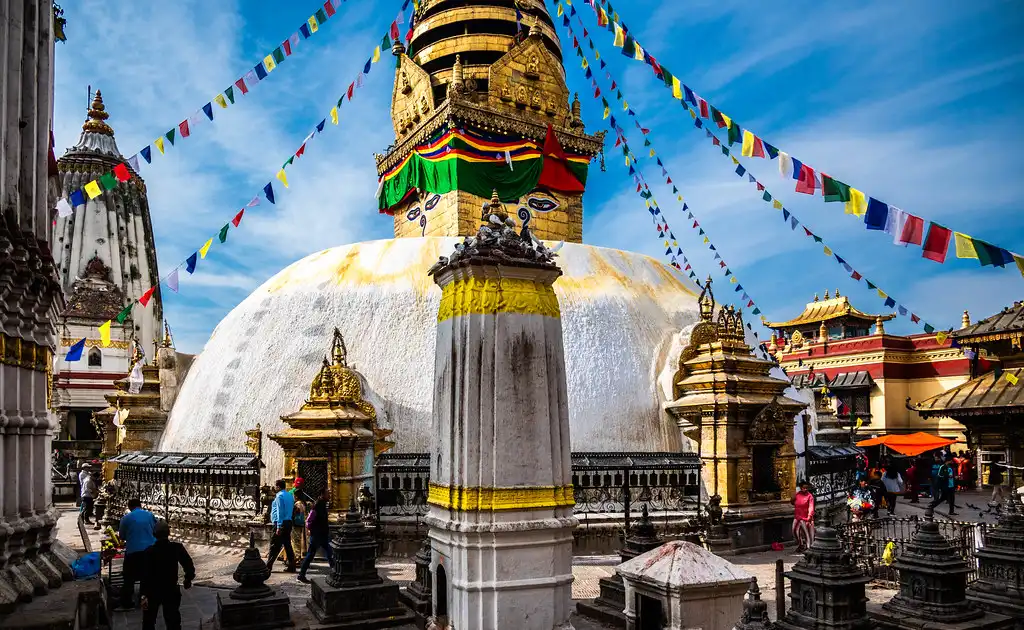
The ideal times for trekking in the Himalayas are the pre-monsoon spring season (March to May) and the post-monsoon autumn period (September to November). These months provide clear skies, stable weather, and moderate temperatures, which are perfect for high altitudes like the Everest Base Camp trek and the Annapurna Circuit trek. Visibility during these periods is excellent, crucial for both safety and enjoying panoramic mountain views.
Wildlife enthusiasts should visit Nepal’s national parks, such as Chitwan and Bardia, from October to December and February to April. These periods, just after and before the monsoon, offer cooler temperatures and lower humidity, making wildlife viewing more comfortable.
Trekking in Nepal
Trekking in Nepal ranks as one of the most sought-after adventure activities, drawing enthusiasts from around the world to its diverse landscapes and majestic Himalayan ranges. The Everest Base Camp Trek, which takes trekkers to the base of the world’s tallest mountain, stands as Nepal’s top trekking destination.
Treks in Nepal vary in difficulty, ranging from easy and moderate to challenging and strenuous, allowing trekkers to choose routes that match their fitness levels, time constraints, and budgets. There’s indeed a trek suitable for every adventurer.
The prime trekking seasons in Nepal are autumn and spring. These seasons provide the best conditions for trekking in regions such as Everest, Annapurna, Langtang, Upper Mustang, and Manaslu. The stable weather, clear skies, and moderate temperatures make these periods ideal for trekking.
Trekking during the winter season (December to February) and the monsoon season (June to August) is generally advised against in these regions. The high probability of snowfall in winter and rain during the monsoon makes trekking particularly challenging and often hazardous.
Trekking in the Annapurna region during the monsoon season is especially discouraged due to the increased difficulty and risks associated with heavy rainfall. Trekkers must remember that weather patterns in Nepal can be unpredictable. Therefore, please always check the latest weather conditions and forecasts before starting a trek to make sure you are safe and ready.
Practical Tips for Planning Your Trip to Nepal
Pack proper clothing and gear for all seasons, including layers for spring and autumn, waterproof items for summer, and thermal wear for winter. You can book international flights to Kathmandu and domestic flights for remote treks well in advance. Reserve accommodations early, especially during peak seasons. Stay hydrated, acclimate properly to high altitudes, and regularly check weather forecasts to ensure a safe and enjoyable adventure.
Tips on Packing and Preparation for Different Seasons
Spring (March to May)
- Clothing: Pack light layers, including moisture-wicking shirts, a fleece jacket, and a waterproof shell. The weather is warm during the day but cooler in the mornings and evenings.
- Footwear: Bring comfortable, broken-in trekking boots and lightweight shoes for camp.
- Gear: Carry a good-quality sleeping bag rated for 0°C to -10°C, trekking poles, and a daypack with a rain cover.
Summer/Monsoon (June to August)
- Clothing: Opt for waterproof and quick-drying clothes, including a rain jacket and pants. Avoid cotton as it takes longer to dry.
- Footwear: Use waterproof trekking boots and gaiters to keep out the mud.
- Gear: Ensure you have a durable rain cover for your backpack, extra plastic bags to keep your belongings dry, and high-quality insect repellent.
Autumn (September to November)
- Clothing: Wear layers of clothes, including thermal underwear, a down jacket, and a windproof outer layer, because it’s hot during the day and cold at night.
- Footwear: Use sturdy trekking boots and comfortable shoes for camp.
- Gear: Bring a warm sleeping bag rated for -10°C to -15°C, trekking poles, and a headlamp with extra batteries.
Winter (December to February)
- Clothing: Wear heavy-duty thermal layers, a down jacket, insulated pants, and warm gloves. Be prepared for temperatures well below freezing.
- Footwear: Use insulated and waterproof trekking boots.
- Gear: Carry a high-quality sleeping bag rated at -20°C, crampons for icy conditions, and a balaclava for extra warmth.
Advice on Booking Flights and Accommodations
Flights
- International Flights: Book your international flight to Tribhuvan International Airport in Kathmandu well in advance to secure the best rates. Compare prices on different travel websites and consider flexible travel dates.
- Domestic Flights: For treks starting in remote areas, such as Lukla for the Everest Base Camp Trek, book your domestic flights early, especially during peak seasons (autumn and spring). Flights fill up quickly, and weather conditions can cause delays, so plan for some buffer days.
Accommodations
- Kathmandu and Major Cities: Book hotels or guesthouses in advance during the peak trekking seasons. Look for accommodations offering amenities like free Wi-Fi, breakfast, and airport transfers.
- Trekking Routes: In popular trekking regions such as Everest and Annapurna, teahouses are available along the trails. During peak seasons, book your stay a day or two in advance, as these can fill up quickly. For more remote areas, consider hiring a guide who can help secure accommodations.
Conclusion
The best time to visit Nepal is during the spring and autumn seasons. These periods offer mild weather, clear skies, and optimal trekking conditions. For those looking to experience Nepal’s cultural festivals, these seasons also host major events like Holi, Dashain, and Tihar.
You should plan your trip ahead of time and choose the right season based on your interests. Whether you’re trekking in the Himalayas, exploring cultural sites, or enjoying wildlife reserves, selecting the appropriate time ensures a memorable and enjoyable adventure.

